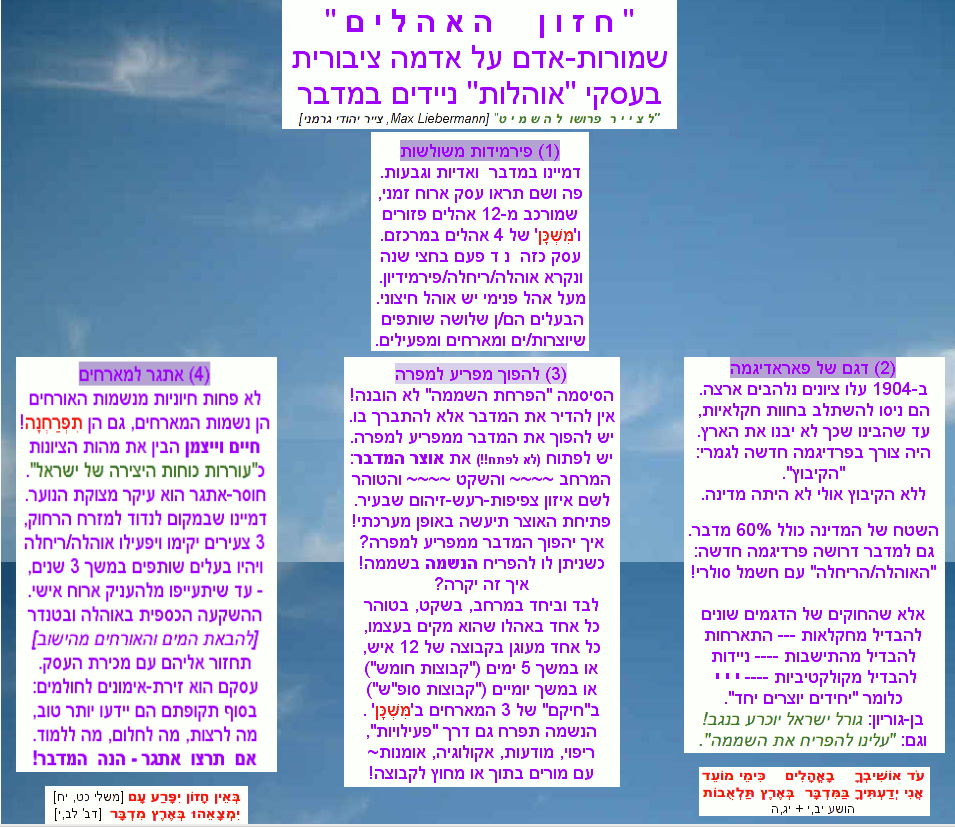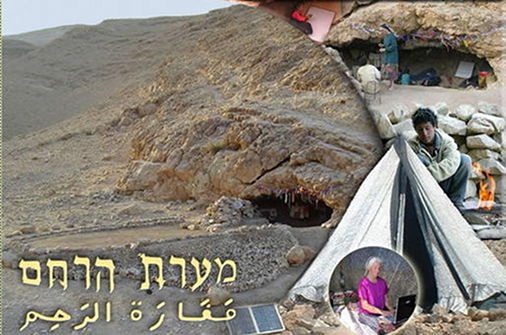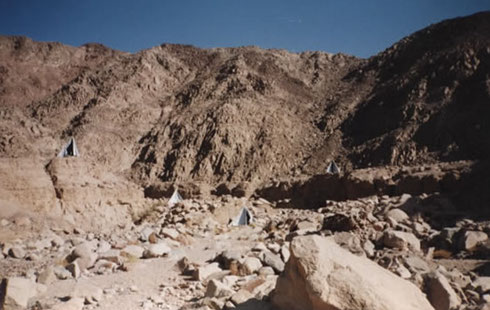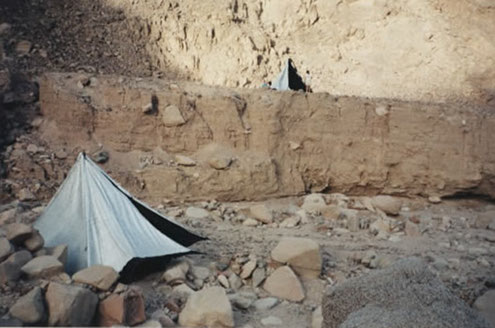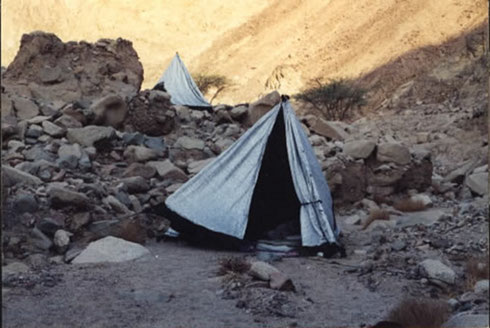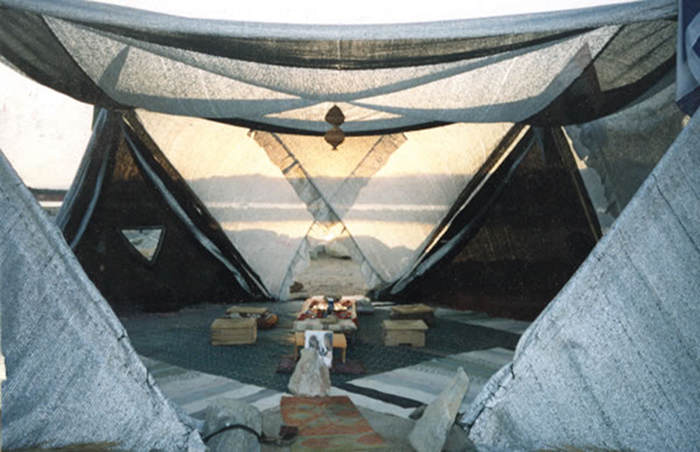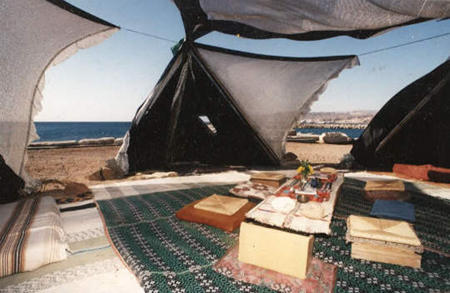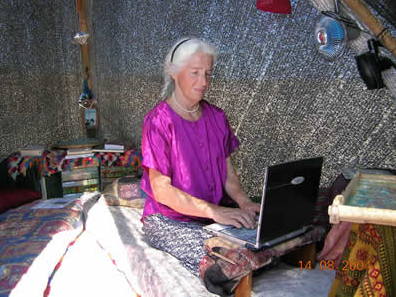E N V I S I O N I N G
the Mobile Desert-Hosting-Economy
The background:
Thorns and thistles, yet I discern "water"
as if flowing out from the cactus-blade.
Ten years from now you will see hundreds of
Ohalot/Rihlaat/Pyramidions
hidden in cosy corners of rocks and wadis
all over the desert of the Negev, the Arava, the SaltSea,
yes all over the mountains of Palestine-Yehuda.
For soon there will go out a "charter"
from the authorities for Nature Protection and Ecological Tourism
in the name of the governments of Israel and Palestine,
that will call creative and brave people.....
to become almost independent entrepreneurs
of mobile Desert Hosting Enterprises.
"Almost" - because there will be rules,
and the keeping of the rules must be controlled.
The call can go out immediately,
for all the experience to begin and to manage a pyramidion
has been gathered for 24 years, since 1990,
(and if I add the
experience with my mobile home, then since 1984)
and is available for rightaway setting up 3 models,
which should prove to whoever is involved
in nature-protection, in ecology and, yes, in economy,
that a mobile Desert Hosting Economy,
based on the Desert Resources of SPS,
Space, Purity and Silence,
is feasable and viable in a way,
that the earth and nature will be left virginal,
Except for a few leveled traces on the earth:
- The triangles for the pyramidal tents,
- the square of the four-tent mishkan,
- the paths between tents and mishkan.
-the trail down to the track that leads to town.
Nothing above the earth will be permanent,
the pyramidal tents will be dismantled once a week,
for each new group of guests will erect their tents.
The entire business will be removed after half a year,
and will wander off to another place for another 6 months.
The purpose of this main rule is not only the protection of the earth.
It is also the condition for keeping the owners/hosts vital in their
creativity
and for involving the guests in the creative aspects of their re-creation.
For the main motive of potential owners-hosts will not be their livelihood,
but their desire to create and to grow, and to be independent and
free.
If after one year and having moved the business after half a year,
the owner-hosts have proven the viability of an Ohalah/Rihlah -
then that relevant authority will declare that the desert is open
for brave and nature-sensitive people, Jews, Bedouins, Palestinians,
to suggest "desert-corners" where they want to start their
business.
The candidates are solely responsible for financing a suitable vehicle,
and the materials for their 16 tents (12 for guests + the mishkan,
composed of 4 tents, 3 for the hosts and 1 for the kitchen,
while the space between them is covered by a shade
and serves for meals, activities and - on the fringes - for storage).
The tents of the first 3 Ohalah/Rihlah models will be fabricated by
hand,
so as to give everyone an idea, how cheap the investment really is.
After all an entire economy of numerous citizens will be based on
it,
and within it Ben-Gurion's prophecy,
that the destiny of Israel will be determined in the Negev.
Of course not only of Israel,
but of all the countries which are mainly desert!
For the first 3 models there will be no office in town,
but a volunteer - pensioner perhaps -
will mediate the registration and arrival of guests.
From the owner-hosts of the first 3 models
no VAT or income-tax will be demanded
not only in order to make their start easier moneywise,
but also in order to not complicate their pioneer work by bookkeeping.
Once this mobile Desert
Hosting Economy will spread out,
there will be two big challenges - Water and Transport,
as long as there are only very few service- places in the desert,
from which to draw food provisions and water.
The vision is, that soon there will come up the structure of
Midbaronim and Midbariyot [desert-villages and desert-municipalities].
But during the first years the Ohalot/Rihlaat will be dependent on
"service places".
This will limit the choice of the "desert-corners" suitable
for a hosting business.
As to the source of water during the first years,
it will depend on the Good Will of the municipality.
Right from the beginning of the spreading of the mobile Desert Hosting
Economy,
researchers and developers - not only in Israel - will be happy about
the challenge,
to renew and upgrade the Nabatean water-technology.
The vision is - an encaved cistern close to every place suitable for
a hosting business.
(details that are already explored - will be given
in time)
A much greater challenge is transport.
SPS and cars are incompatible!!!
And even if the rules say: - only an open
truck,
which can transport water, food-ingredients twice a week,
+ 6 guests, (and drive twice to get the other 6 coming guests)
there still need to be trails that get close to the Ohalah/the Rihlaah,
and that can hardly be parked without disturbing the view of the guests
and without been stolen.
As to the arrival of the guests: it will be their responsibility,
if they want to park their cars in town or prefer public transport.
Now to the target-group of the guests
and the management of a mobile desert hosting business:
First principle: only a group of 12 people can be hosted.
the group might be organized , with a teacher,
or the first people who register, find other people to join them.
The price is for 12 people and if only 4 come, they still have to
pay for 12.
The price is either for 5 days: the Chumash-guests
or for 2 days: the weekend-guests.
If one of the group or the entire group do not want to stay 5 or 2
days,
they still must pay for 5 or for 2 days.
This not only allows for a price that is extremely low
which makes this kind of recreation available almost for every person,
it also enormously simplifies the accounting
work of the hosts.
It will also allow them sometimes to take
a week off and rest.
The prices which are suggested for the
first 3 models:
a Chumash-group
pays - per person and day - 60 NIS = 12x5x60 = 3600 for 5 days
a Shabbat-group pays - per person and day - 100 NIS = 12x2x100 =2400
for 2 days.
For the owner-hosts this means: 6000 NIS per week = 24000 NIS per
month,
minus maximum 6000 NIS for food, water, fuel (car) and gas (cooking,
baking)
and perhaps some return for the investment of tent-materials, solar
panels and car.
Thus each of the 3 hosts will have an income of 6000 NIS,
[minus 1000 NIS for VAT and income tax
a f t e r the experimental year]
which s/he can spend on his/her flat at home or on future studies
and dreams.
The functioning
of an Ohalah/a Rihlaah:
Though the guests come as a group, everyone is free to do what s/he
wants,
unless they decide - beforehand or while there - to do or learn or
heal together.
Everyone of the 12 will have his/her own tent and erect it after his/her
arrival.
[There will be a small model in the mishkan, written
and video guidance].
If people (couples) still want to sleep or be together in a tent,
it's up to them.
What is important, is the freedom to choose al-one-ness or togetherness.
In the tents they find 2 mattresses , one along each of two edges,
while the third edge [tzaela'] is composed of
2 "curtains"
[there is no word for the biblical yeri'ah
- so vital for the pyramidal tent - in English!]
which allow the game of opening and closing the two "gates",
according to sun and shade, wind and lack of wind, day and night.
There will be a portable solar panel for
a lamp and a vent in summer,
and it's up to the guest to turn the panel to the sun along the day.
The earth is covered by mats and between the mattrasses
(for which the guests bring their own sleeping-bag or sheets -blankets
will be provided)
there is a kind of table+box for their private equipment, computer,
books etc.
There also is a water-container, a washing-bowl and a closed vessel
for body-wastes.
As to the Mishkan, the owner-hosts will do everything,
to keep the storage of equipment and food-ingredients to a minimum.
Why three owner-hosts? Or one owner with two assistants?
It is vitally important, that always at least one host can rest.
To rest means to be al-one, no people, no conversation.
Only someone who has opened his/her heart to guests
time and again, for a week, for weeks, for months,
can know, how much strength this takes.
But without an open heart on the part of the host,
the Desert Hosting Business will not succeed!
Also the hosts need more than relative convenience in their work,
and regular rest and al-oneness.
They need support for processing their feelings and experiences,
and they need guidance for improving their way of hosting.
In the year of the scientific experiment with 3 models,
the people who can guide and support will be volunteers,
perhaps from among the oldtimers of Succah in the Desert.
As to the activities, excursions, workshops etc. of the guests,
of both, the Chumash-Guests and the Weekend-Guests,
the possibilities are endless and don't need to be listed here.
As to the relationship
between the Authorities
and the mobile Hosting Enterprises,
see the Hebrew presentation.
